“Illoyal, Lawless, Irreligious Banditti”
Published in 18th–19th - Century History, Features, Issue 4 (Winter 1999), Volume 7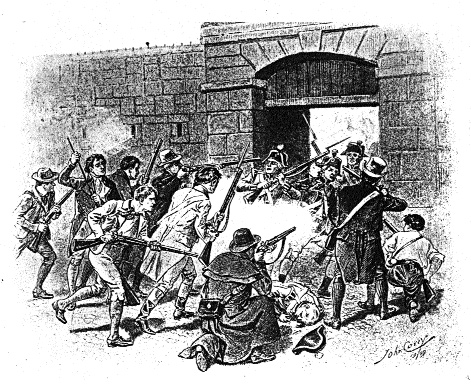
The Hearts of Steel storming the barracks at Belfast, December 1770. (Linen Hall Library)
In the 1770s, twenty years before the United Irishmen, there occurred an armed rising by the poor people of Ulster, mainly Presbyterians, against injustice and oppression. The rising was to last almost four years. It witnessed assemblies of armed men, the storming of towns and even battles. Writing a hundred years later, W.E.H. Lecky described it as a ‘formidable insurrection’. To many at the time it seemed that society was about to be overthrown and even the influx of large numbers of troops into the area did not immediately put an end to it. The alarm engendered by this insurrection is clear in a letter from a landlord to Sir George Macartney, the Lord Lieutenant’s secretary:
I want proper words to convey adequate ideas to picture the danger I have reason to believe my own life, the lives of my family, and the utter destruction of my worldly substance is in, from an abon’d, illoyal, lawless, irreligious banditti who have armed themselves in this part of the country to the great terror of every of his majesties liege subjects, and more especially to those of them that enjoy any kind of property.
In the second half of the eighteenth century King George III and his government still lived in fear of a repeat of the 1745 Jacobite rebellion. However, this rising was started by poor tenants fearful of eviction.
Donegall’s debts
In 1769 the fifth Earl of Donegall was among the largest landowner in Ireland. His estates were counted in thousands of acres. Even one of his tenants might lease as much as 7,000 acres, which would be sub-let to farmers in small plots. He also had estates in England and along with the title inherited the accumulated debts of his forefathers. Faced with large debts and expenses, the fifth earl needed to raise money badly. He decided to make his estates in Ulster financially viable. The plan was to replace the smaller tenants with more substantial ones so as to increase the rents and to charge fines for the granting of new leases. This overhaul began on lands held by the middleman, Clotworthy Upton, and was immediately opposed by the tenants there. These tenants banded together for mutual support, refusing to pay increased rents or to accept new leases. Their great fear was that the changes proposed by Lord Donegall would result in the eviction of hundreds of families. They carried out acts of violence against Clotworthy Upton and tenants who accepted new leases. As the re-organisation spread to lands held through other middlemen (as well as those held from Lord Donegall directly) so too did the violent protest. The rebellious tenants became more organised, forming recognisable groups under specific leaders. They became known as the ‘Hearts of Steel’, or ‘Steelboys’, and under this name carried on a campaign of protests and outrages for the next four years. Lord Donegall was not the only landlord who was attempting to improve his estates, nor the only one to give offence to his tenants, and so other tenants followed their example and formed Steelboy groups. Their grievances related not only to landholding but also to paying tithes to the established church and the county cess.
Tithes and cess
Tithes were a portion of income, nominally one tenth but in reality less, paid annually to the Church of Ireland, whether one belonged to it or not. The cess was a tax which officially went to the upkeep of public roads in a particular county. The rate at which cess was levied and on what it was spent was decided by the local Grand Jury, usually composed of local landlords and magistrates. Once Steelboy groups were successfully established in certain areas, their attention broadened to other issues where they felt justice was not being done, including the price of bread and potatoes.
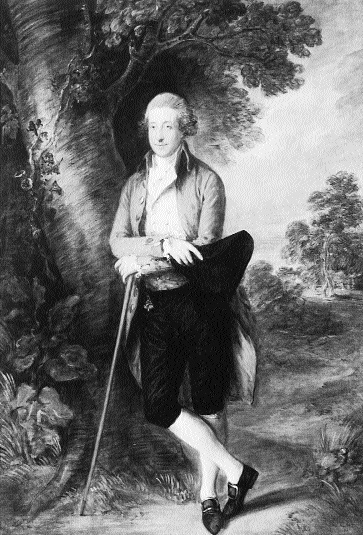
Arthur, fifth Earl and later first Marquess of Donegall (1739-99) by Thomas Gainsborough. His attempts at reducing his debts sparked off the crisis. (National Museums and Galleries of Northern Ireland)
The Steelboys were in the main Presbyterian small tenants who held land from a middleman and farmed plots of a few acres. Most would also have been involved in the weaving trade, either to supplement their income or as their primary occupation. In the eastern counties of Ulster, the linen industry was dominant and almost everyone, directly or indirectly, depended upon it. Merchants were involved in the manufacture and sale of linen, and farmers who were not weavers or drapers themselves usually leased part of their land to linen workers. The dependence on linen in part explains the insecurity and fear of the poorer tenants for the industry had recently fallen on hard times and it was they who were hardest hit by the economic depression.
Steelboy groups emerged in four counties: Antrim, Down, Armagh and Derry. They carried on a campaign of violence: burning houses, destroying crops, maiming livestock and attacking, even killing, individuals who opposed them. At the height of the troubles, there were as many as four serious outrages a week. In many districts the insurrection was so complete that the Hearts of Steel almost completely usurped local government. They issued proclamations regulating rent, tithes and the price of provisions. For example, the following order was sent to James Watson, Brookhill, County Antrim:
You are hereby required to give out the beef to your poor tenants that is in a starving condition, and to let you know that as many as shall hereafter come upon the ground of MacCullum’s farm shall be dealt with in the same manner, ‘till such time as you shall settle with your tenants, and you must sell out your hay to your tenants at 1s. 1d. per hundred, and let no more of it go away from them or we will destroy it. Given under our hands, this 20th March, 1772. Hearts of Steel.
They held assemblies, openly petitioned the Dublin government and paralysed the officers of the law and local authorities. One memorial to Lord Townshend, the Lord Lieutenant, complained that:
Large bodies of people have at different times assembled in the said County [Armagh], and have marched armed to different places threatening to burn the houses and effects of such magistrates, constables or persons, as should dare to give any aid or assistance in collecting more money upon any of the accounts aforesaid than the rates particularly specified by them.
The storming of Belfast
A favourite tactic was to swamp a town or village with supporters to demand arms or money and to impose oaths. When one of their leaders, David Douglas, was arrested and jailed in Belfast in December 1770, they stormed the town and secured his release. Douglas had been arrested by Waddell Cunningham, a County Antrim landlord.
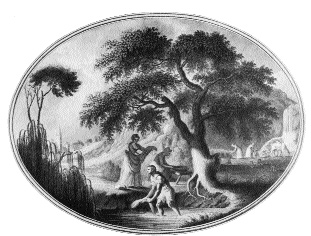
Engravings by William Hincks of flax growing in Hillborough, County Down
He was lodged in Belfast barracks to await trial. When word of his capture spread, local people from the countryside around, the great majority tenants on the Donegall estates, marched on Belfast. Outside the town they were organised into columns by an old soldier, Nathaniel Matthews, under the command of prominent Hearts of Steel. They surrounded the barracks and demanded Douglas’s release, communicating with Stewart Banks, the Sovereign of Belfast, in written messages. While negotiations continued, Cunningham’s house was ransacked by the Steelboys and the house of Dr Halliday also attacked. However it was due to Halliday, who was himself a landlord, that a major battle in the town was avoided. In the course of the negotiations, soldiers fired upon the crowd killing three people. At this point the Steelboys, many of whom were armed with muskets and pistols, would have stormed the barracks if Dr Halliday had not intervened to plead for calm and act as a mediator. Eventually Douglas was released and carried off to safety.
This was probably the most famous incident in the Steelboy insurrection and became the subject of a popular ballad:
The twenty-third of December away we did go,
To visit Belfast—for it must be so—
To seek for our brother, if that he was there,
And straight to release him no pains would we spare.
We went to the barracks and there we did stand
And of Banks and Cunningham we did demand
The pris’ner in durance, we knew not for what cause,
But as they pretended he had broken their laws.
Then Banks he made answer, and this he did say:
‘We’ll not lose our prison[er] any such way,
For on to morrow morning before break of day
We’ll hire a boat and hoise him away.’
Now the gate was thrown open and there was displayed
The soldiers in arms as they stood on parade,
But with treachery base they poured forth their shot
And three of our brave heroes lay dead on the spot.
The battle of Gilford
A similar incident occurred in Gilford, County Armagh, when a ‘battle’ was fought between the Steelboys and the forces of the local magistrate, Richard Johnston. When the Steelboy agitation broke out, he formed an unofficial force of about fifty men drilled by an old soldier named Adamson, to deal with the disturbances. Among this force was a dissenting minister, Samuel Morrell, who, despite official reports does not seem to have been popular with his parishioners. Johnston, too, appears to have been unpopular in the neighbourhood and to have had bad relations with certain individuals later bought to trial in Dublin. This vigilante force captured some leaders of the Hearts of Steel and a contemporary account relates:
Next day they sent him [Johnston] a message that if he did not deliver up their men that they would burn his house and kill himself. And to prepare for the undertaking, they went into Lurgan, and obliged the people there, to supply them with all the guns in the town, and ammunition, and on Thursday they went to attack Mr Johnston. On his discovering his resolution of defence, they began to fire at the windows and set the offices on fire, the fire was returned from the house, and three as they say of their men killed. Upon which Mr Morell, a dissenting minister, neighbour to Mr Johnston, desirous to prevent farther bloodshed, drew up a window in order to spake [sic] out to them but was saluted by four musket balls in his head and breast, he fell dead out of the window, and his body it was said, was treated by these inhuman people, to many pelts with stones etc..
Mr Johnston hung out a flag of truce on loosing [sic] his chaplain, who was a man of excellent character, and during the attempt to settle preliminaries of peace Mr Johnston escaped out of a back window, and fled on foot, but was so closely pursued, that he was obliged to swim the Bann, and had several shots fired at him, in the water.
Sympathy for the rebels
The landlords and local authorities in Ulster were much alarmed by the Steelboy activities and appealed to the Dublin government for aid. However, the lord lieutenant’s sympathies were with the poorer tenants whom he believed to be the victims of the greed of ruthless landlords.
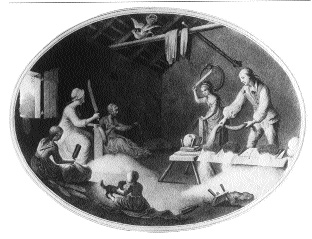
‘the common method of beetling, scutching, and hackling the flax’. The linen industry had fallen on hard times and this contributed to the unrest. (Linen Hall Library)
This was a widely held belief outside Ulster. Even George III let it be known he too accepted that ‘they owe their rise to private oppression, [and] the over greediness and harshness of landlords’. Added to this the fact that juries in local courts refused to convict Steelboys for similar reasons, it seemed that the Hearts of Steel would succeed not merely in achieving their aims but in breaking the landlord class in Ulster.
However, the lord lieutenant did not let his sympathies blind him to his duty to maintain order and the authority of government. So towards the end of 1771 he ordered large numbers of soldiers into the province. The military and the Steelboys frequently exchanged shots as patrols came upon a party of ‘insurgents.’ In response to the failure of local juries to convict the Hearts of Steel, the Irish parliament, itself the representative of the landed interest, passed an act enabling trials to be removed from the Ulster courts to Dublin where, it was believed, an impartial jury would bring in a conviction.
The Trials Act turned out to be a farce as every suspect brought to trial in Dublin was acquitted. In August 1772, William Redmond, the leader of the Steelboys at the battle of Gilford, and a number of others were tried there. Their defence counsel, Mr Hussey Burgh
opposed the mode of trial on the grounds that the removal of the culprits from their vicinity to a distant part of the kingdom, was unconstitutional. He urged his arguments with so much force as to produce a powerful impression on the jury who (after almost every fact alleged was fully substantiated) in seventeen minutes brought in a verdict, ‘not guilty’.
The story did not end there, however, for Redmond was again tried in Armagh where he was also acquitted. The judiciary in County Armagh had already been undermined by the over-ruling of its decision at the 1770 assizes and suspension in 1772 of Judge Christopher Robinson, who was himself to suffer from the disturbances.
Co-ordinated suppression
However, by 1772 all the forces of government and order were marshalled against the Hearts of Steel. The troops prevented many of their rallies and protected victims from attack. The churches too, Presbyterian and Church of Ireland, condemned the Steelboys. While there is some evidence to suggest that Presbyterian ministers sympathised with the tenants, they exhorted them to desist from violence. More importantly, the landlords and magistrates used their influence to ensure the conviction of suspects at local assizes. Juries were carefully selected so that the landlords and their friends sat in judgement of those accused of Steelboy crimes. Many were hanged. For example, in April 1772 at Carrickfergus eight Hearts of Steel were sentenced to death, two were imprisoned and a further eight were held in custody.
Faced with a common enemy the landlords formed, if not their own societies, then informal associations for mutual aid. In their official capacity as law officers they co-operated but they also formed armed vigilante groups recruited from among the loyal tenantry. Johnston was rewarded with a baronetcy for his endeavours against the Hearts of Steel and he was not the only landlord to act in this way. These vigilantes were used to provide protection for houses or individuals threatened. Rewards for Steelboys were put forward by all, or a large number, of the landlords in a given area. It was also the landlords who found witnesses for trials and co-operated to procure convictions. For example, George Portis, Donegall’s agent, reported to the earl after the assizes in September 1771, that ‘Banks, Greg, Cunningham [local landlords] and every well-wisher of your lordship did use their utmost endeavours to have some examples made’.
So it was that a counter-campaign was organised. In County Antrim a magistrate, James Leslie, co-ordinated activities against the Hearts of Steel. He was in charge of a fund collected by the local gentlemen, and to which Lord Donegall contributed, used to ‘defray expenses’ in prosecuting those accused of agrarian crimes. Leslie also organised the capture of any Steelboys who fled the law. A report from May 1772 stated that ‘young Blair [leader of a Steelboy group] was taken in Glasgow by a party sent in pursuit of him by Jas. Leslie’.
The economic situation continued to deteriorate thus making subsistence on the land increasingly precarious. This made the position of the rebellious tenants even more difficult to maintain. Huge numbers began to emigrate to America.
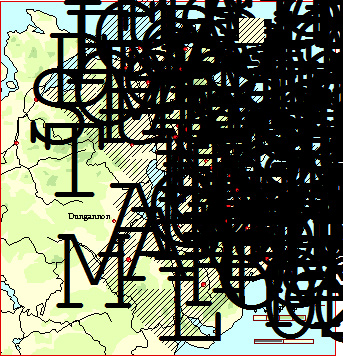
(Matthew Stout)
The closing months of 1772 and the beginning of 1773 saw a petering out of the Steelboy activity in the face of the re-assertion of authority, continuing economic hardships and emigration. Although some continued to carry on the campaign, by the summer of 1773 the Steelboy insurrection was over.
From history into myth
The Hearts of Steel may have been beaten but they passed from history into myth. They were praised in songs and stories (popular in east Ulster well into this century) as champions of the oppressed poor. The story arose that many emigrated with their families to America where they were at the forefront in the War of Independence. The Ulster landlords were portrayed as greedy villains and the Steelboys as noble heroes. The fact that Lord Donegall was in dire financial straits and needed money badly was forgotten. John Wesley, the founder of Methodism, and Arthur Young, the agricultural reformer, visited Belfast some years later and were told this version of events which they duly included in their books.
However, the Hearts of Steel were also to have a lasting impact on the subsequent development of both radical and conservative politics in Ireland. The armed vigilante groups of tenants organised by landlords were the forerunner of the Volunteer companies formed in the 1770s. For example, twenty years after the Steelboy troubles, Waddell Cunningham led a Volunteer company to evict troublesome tenants in the barony of Masserene, County Antrim. Ironically they were also to form the engine for the Patriot movement led by Henry Grattan that achieved major reforms of the Irish parliament in 1782.
As the first major rising by a secret society in Ulster they were a model which later groups of discontented tenants followed. The Hearts of Steel legitimised, for Presbyterians in particular, rising up against the authorities in the pursuit of justice. After the Hearts of Steel came a series of secret societies which ultimately led to the Peep O’Day Boys, forerunners of the Orange Order, and the Defenders, who became absorbed into the United Irishmen. Jemmy Hope, the United Irishman, for example, recalls seeing the Hearts of Steel as a child and this influenced his radical politics. Many of those who gathered at Donegore Hill on 7 June 1798 had been out as Hearts of Steel twenty-five years before.
Tony Canavan is an editorial consultant and member of the editorial board of History Ireland.
Further reading:
F.J. Bigger, The Ulster Land War of 1770 (Dublin 1910).
W.E.H. Lecky, Ireland in the Eighteenth Century (London 1892).
R.M. Young, Historical Notices of Old Belfast and its Vicinity (Belfast 1896).
















